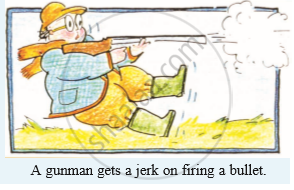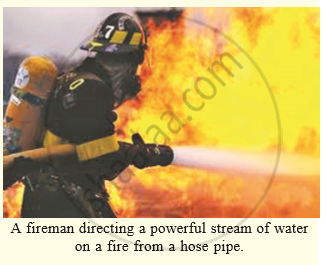Advertisements
Advertisements
Question
A stone of 1 kg is thrown with a velocity of 20 m s−1 across the frozen surface of a lake and comes to rest after travelling a distance of 50 m. What is the force of friction between the stone and the ice?
Solution
Mass of the stone (m) = 1kg
Distance travelled (s) = 50 m
Initial velocity of the stone (u) = 20 m/s
The final velocity of the stone (v) = 0 m/s
From the third equation of motion
v2 - u2 = 2as
02 - (20)2 = 2 × a × 50
02 - (20)2 = 100a
a = `(-400)/100`
a = -4 m s-2
The frictional force between the stone and ice
F = m × a
F = 1 × -4
= -4 N
Therefore, the frictional force between the stone and ice = -4 N
APPEARS IN
RELATED QUESTIONS
Explain, why is it difficult for a fireman to hold a hose, which ejects large amounts of water at a high velocity.
Using a horizontal force of 200 N, we intend to move a wooden cabinet across a floor at a constant velocity. What is the friction force that will be exerted on the cabinet?
Is the following statement true or false :
A rocket can propel itself in a vacuum.
What is the force which produces an acceleration of 1 m /s2 in a body of mass 1 kg ?
A girl weighing 25 kg stands on the tloor. She exerts a downward force of 250 N on the floor. What force does the floor exert on her ?
Why does a gunman get a jerk on firing a bullet ?
Explain how a rocket works.
Name the law involved in the following situation :
when person A standing on roller skates pushes another person B (also standing on roller skates) and makes him move to the right side, then the person A himself gets moved to the left side by an equal distance.
State Newton’s third law of motion and give two examples to illustrate the law.
Give scientific reasons.
It is easier to stop a tennis ball as compared to a cricket ball when both are travelling with the same velocity.
